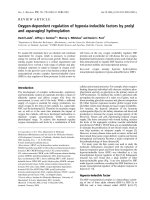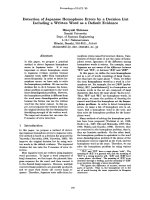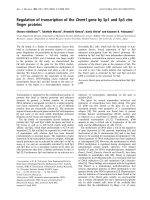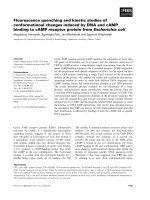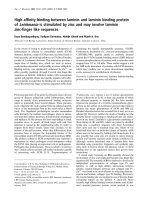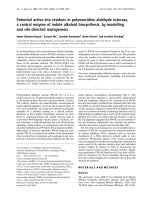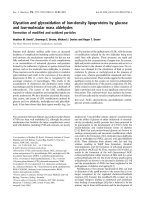Detection of biologically relevant anions by fluorescence and NIR molecular probes
Bạn đang xem bản rút gọn của tài liệu. Xem và tải ngay bản đầy đủ của tài liệu tại đây (2.56 MB, 211 trang )
DETECTION OF BIOLOGICALLY RELEVANT
ANIONS BY FLUORESCENCE AND NIR
MOLECULAR PROBES
QUEK YI LING
NATIONAL UNIVERSITY OF SINGAPORE
2011
DETECTION OF BIOLOGICALLY RELEVANT
ANIONS BY FLUORESCENCE AND NIR
MOLECULAR PROBES
QUEK YI LING
(B. Sc.(Hons.), National University of Singapore)
A THESIS SUBMITTED
FOR THE DEGREE OF DOCTOR OF
PHILOSOPHY
DEPARTMENT OF CHEMISTRY
NATIONAL UNIVERSITY OF SINGAPORE
2011
Acknowledgements
First and foremost, I wish to express my deepest gratitude to my supervisor
Prof Huang Dejian for his valuable supervision, patient guidance and
encouragement given throughout the project. I feel honoured to have him as
my supervisor and have learnt from him his invaluable ideas, profound
knowledge, and rich research experience. Without his encouragement, I would
not have embarked on my PhD studies. I am also deeply grateful to his
kindness throughout the four years and his efforts of guiding me to complete
my research project and thesis.
I also wish to extend my sincere gratitude to NUS for research scholarship
and Singapore Ministry of Education (Grant No. R-143-000-299-112) and
Science and Engineering Research Council of the Agency for Science,
Technology and Research (A*Star) of Singapore (Grant No. 072-101-0015)
for financial support in the project.
Next, I would like to express my sincere gratitude to Ms Tan Ying Ying
and Ms Wenie Chin, my UROPs and honours year students respectively, for
their contribution in determining the pro-oxidant activity of tea leaves, tea
catechins and doing the DNA cleavage experiments. I also wish to thank Prof
Li Tianhu and Dr Wang Yifan for their knowledge and expertise in the DNA
cleavage assay setup.
I would also like to express my heartfelt appreciation to Dr Wang Suhua,
Dr Yao Wei, Dr Feng Shengbao, Dr Viduranga Yashasvi Waisundara, Dr Koh
Lee Wah, Dr Fu Caili, and Ms Chen Wei for their advice and technical
assistance rendered throughout the project. In addition, I would like to express
i
my appreciation to Ms Lee Chooi Lan, Ms Lew Huey Lee, Ms Jiang Xiaohui,
and Mr Abdul Rahman bin Mohd Noor for their excellent technical support. I
am also grateful to NUS Chemical, Molecular and Materials Analysis Centre
(CMMAC) for its technical assistance.
Last but not least, I would like to thank my family members for their love
and unwavering support. I wish to express my sincere appreciation to my
boyfriend for his constant encouragement during the process of my thesis
writing. I wish to sincerely thank my mentor in life Dr Daisaku Ikeda, my
cousin, my friends, and my comrades in Singapore Soka Association for their
encouragement and continuous support during the four years of my PhD
studies. From the bottom of my heart, I thank all my friends whose name may
not have been mentioned here, but have never hesitated to give me their
helping hands whenever I need help.
Quek Yi Ling
August 2011
ii
Table of Contents
page
Summary...........................................................................................................x
List of Figures...........................................................................................xii
List of Tables.................................................................................................xvii
List of Abbreviations...................................................................................xviii
Part I: Hydroethidine as a Fluorescent Probe for Quantifying Pro-oxidant
Activity of Polyphenolic Compounds
Chapter 1 Introduction on Pro-oxidants
1.1. Reactive oxygen species and oxidative stress……………....................1
1.2. Structure and antioxidant activity of flavonoids.....................................2
1.2.1 Chemical structure of flavonoids.....................................................3
1.2.2 Antioxidant activity of flavonoids...................................................4
1.3 Pro-oxidant activity of flavonoids……………………………………...8
1.3.1 Pro-oxidant activity in the absence of transition metals..................9
1.3.2 Pro-oxidant activity in the presence of transition metals or
peroxidases……………………………………………………………10
1.3.3 Pro-oxidant activity in terms of DNA damage and lipid
peroxidation……………………………………………………………13
1.3.4 Pro-oxidant activity in terms of enzyme and topoisomerase
inhibitors.................................................................................................14
1.3.5 Pro-oxidant activity in terms of cancer therapy.............................16
1.4. Pro-oxidant activity assays...................................................................17
1.4.1 Deoxyribose assay.........................................................................17
iii
1.4.2 Other pro-oxidant assays…………………………………………18
1.5 Detection methods of superoxide..........................................................21
1.5.1 Spectrophotometric probes............................................................22
1.5.2 Fluorescent probes ………………………………………………23
1.5.3 Luminescence probes.....................................................................25
1.5.4 Electron spin resonance and spin trapping ………………………27
1.6 Aim of this research...............................................................................28
Chapter 2 Pro-oxidant Activity of Flavonols Quantified by a Fluorescent
Probe Hydroethidine
2.1 Introduction............................................................................................30
2.2 Materials and methods..........................................................................31
2.2.1 Materials........................................................................................31
2.2.2 Instruments....................................................................................32
2.2.3 Preparation of stock solutions........................................................32
2.2.4 HPLC analysis of oxidation product of HE with flavonols..........33
2.2.5 Reaction between HE, flavonol and potassium superoxide...........34
2.2.6 Pro-oxidant assay procedure..........................................................34
2.2.7 UV-vis kinetics measurement of HE oxidation by myricetin.......35
2.2.8 pH dependency of HE oxidation by myricetin..............................36
2.2.9 Myricetin decomposition in the presence and absence of HE.......36
2.2.10 Determination of acid dissociation constants (pKa) of flavonols.37
2.2.11 Measurement of oxidation potentials of flavonols.......................37
2.2.12 Determination of DNA cleavage.................................................38
2.3 Results and discussion...........................................................................39
2.3.1 HE oxidation by myricetin.............................................................39
iv
2.3.2 Quantification of pro-oxidant activity of flavonols.......................45
2.3.3 DNA cleavage activity of flavonols......................................47
2.4 Conclusion.............................................................................................51
Chapter 3 Evaluation of Pro-oxidant Activity of Different Tea Leaves
3.1 Introduction...........................................................................................53
3.1.1 Tea processing and its polyphenol composition............................53
3.1.2 Health effects of tea.......................................................................55
3.1.3 Pro-oxidant activity of tea..............................................................56
3.1.4 Aims & objectives..........................................................................57
3.2 Materials and methods.........................................................................59
3.2.1 Materials........................................................................................59
3.2.2 Instruments....................................................................................60
3.2.3 Preparation of stock solutions........................................................60
3.2.4 Extraction of tea samples...............................................................60
3.2.5 Pro-oxidant assay procedure…………………………….............61
3.2.6 Quantification of polyphenols in tea samples................................61
3.2.7 Total phenolic assay procedure......................................................62
3.2.8 Oxidation product of HE with tea catechins and theaflavins.........63
3.2.9 Determination of acid dissociation constants (pK a ) of tea
catechins……………………………………………………………….63
3.2.10 Measurement of oxidation potentials of tea catechins.................63
3.2.11 Determination of DNA cleavage.................................................63
3.3 Results and discussion...........................................................................64
3.3.1 Oxidation product of HE with tea catechins and theaflavins….....64
v
3.3.2 Quantification of pro-oxidant activity of tea catechins, theaflavins,
gallic acid, methyl gallate, pyrogallol, and tea samples….....................64
3.3.3 Quantification of major polyphenols in tea extracts......................68
3.3.4 Effect of pH on pro-oxidant activity of EGCG, theaflavins and tea
extracts…………………………………………………........................77
3.3.5 Redox potential and acid dissociation constants of tea catechins..79
3.3.6 DNA damage induced by tea catechins……………….................83
3.4 Conclusion.............................................................................................87
Part II: Bimetallic Complexes of Ruthenium and Iron as Near-IR Probes
for Detection of Redox-Active Molecules
Chapter 4 Literature Review on NIR Active Bimetallic Complexes of Ru
and Fe
4.1 Introduction on NIR active metal complexes........................................89
4.2 NIR absorption by metal complexes containing radical ligands...........90
4.2.1 Iron(II)-2,2’-bipyridine complexes…............................................91
4.2.2 Ruthenium(II) dioxolene complexes………..................................92
4.3 NIR absorption by mixed-valence dinuclear complexes……...............96
4.3.1 Classification of mixed-valence dinuclear complexes...................96
4.3.2 Physical properties of mixed-valence complexes..........................98
4.3.3 Mixed-valence complexes with bis-monodentate bridging
ligands…………………………………………………………….........99
4.3.4 Mixed-valence complexes with bis-bidentate bridging ligands...101
4.3.5 Mixed-valence complexes with bis-tridentate bridging ligands..102
4.3.6 Mixed-valence complexes with bis-tetradentate bridging
ligands…………………………………………………………….......103
vi
4.4 NIR absorption from mixed-valency of coordinated radical ligands..108
4.4.1 Bis(-iminopyridine)iron(II) complexes.....................................108
4.4.2 Bis(dithiolene)iron(III) complex………………………………109
4.5 Applications of NIR active dinuclear complexes…………………....110
4.5.1 Application in electro-optic switching…………………….........110
4.6 Aim of this research.............................................................................112
Chapter 5 Air Oxidation of HS- Catalyzed by a Mixed-Valence
Diruthenium Complex, a Near-IR Probe for HS- Detection
5.1. Introduction.........................................................................................114
5.2 Materials and methods.........................................................................115
5.2.1 Materials......................................................................................115
5.2.2 Instruments...................................................................................116
5.2.3 Preparation of stock solutions......................................................117
5.2.4 Construction of standard curve of NaHS with [Ru2]+…............117
5.2.5 Reaction of NaHS with [Ru2]+ under a nitrogen atmosphere…..118
5.2.6 Reusability of [Ru2]+ for HS− quantification….........................118
5.2.7 Oxidation of HS− catalyzed by 5% [Ru2]+.................................119
5.2.8 Measurement of H2O2 formed from HS− oxidation...................119
5.2.9 Extraction of HS2− from HS− oxidation with 5% [Ru2]+......…120
5.2.10 Selectivity of [Ru2]+ towards anions and reductants................120
5.2.11 Replacement of axial Cl− ligands of [Ru2]+ with F−................121
5.2.12 Method validation......................................................................121
5.2.13 Measurement of H2S release from GYY4137 using [Ru2]+…..122
5.3 Results and discussion.........................................................................122
5.3.1 Sensitivity of [Ru2]+ towards HS−.............................................122
vii
5.3.2 Reversibility of the reaction of [Ru2]+ with HS− in the presence of
oxygen...................................................................................................123
5.3.3 Reusability of [Ru2]+ for HS− quantification.............................124
5.3.4 Oxidation of HS− catalyzed by 5% [Ru2]+ ………….…............125
5.3.5 Selectivity of [Ru2]+ towards anions and reductants………....130
5.3.6 Method validation…………………………….........................131
5.3.7 Measurement of H2S release from GYY4137 using [Ru2]+…...132
5.4 Conclusion...........................................................................................134
Chapter 6 Synthesis and Characterization of NIR Active Diiron
Complexes and Their Reactivity with Redox-Active Molecules
6.1 Introduction..........................................................................................135
6.2 Materials and methods.........................................................................135
6.2.1 Materials......................................................................................135
6.2.2 Instruments...................................................................................136
6.2.3 Preparation of stock solutions......................................................136
6.2.4 Synthesis of Fe 2 TIED(CN) 4
and [Fe 2 TIED(RNC) 4 ] 4 +
complexes…………………………………………………………….137
6.2.5 Procedures for sensing redox-active molecules……...................139
6.3 Results and discussion.........................................................................140
6.3.1 Synthesis of complexes 1 and 2...................................................140
6.3.2 Spectroscopic characterization of complexes 1 and 2.................142
6.3.3 Comparison of NIR band shift for [Fe2]4+, 1, and 2...................153
6.3.4 Reactivity of complexes 1 and 2 with redox-active molecules…154
6.4 Conclusion...........................................................................................157
6.5 Future work..........................................................................................158
viii
List of Publications and Patent...................................................................159
References.....................................................................................................160
Appendices (CD attached)
ix
Summary
The first part of the thesis documented the efforts to establish a convenient
assay making use of a fluorescent probe hydroethidine (HE) to quantify the
superoxide radical forming pro-oxidant activity of flavonols under
physiologically relevant conditions. In the presence of the flavonols myricetin
and quercetin, oxidation of HE by superoxide yielded ethidium instead of 2hydroxyethidium. The reaction is inhibited by added superoxide dismutase,
suggesting that superoxide is involved in the rate limiting step of the oxidation.
The superoxide formation rates were quantified from the oxidation kinetics
and myricetin was found to have the highest pro-oxidant activity.
This assay was then applied in quantifying the pro-oxidant activity of
different tea leaves. The pro-oxidant activity decreases in the order of black
tea > oolong tea > green tea. Hence there is evidence that the pro-oxidant
activity of the tea leaves at pH 7.40 increases with the degree of fermentation.
The major tea catechins, theaflavins, and gallic acid present in the tea samples
were quantified using reverse phase-high performance liquid chromatography.
Theaflavins are found to be better pro-oxidants than tea catechins. However,
the total pro-oxidant activities of each tea sample correlate poorly with the
sum of the weighted pro-oxidant activities of the phenolic compounds
quantified in the tea extract.
In the presence of Cu(II), the DNA damaging pro-oxidant activity is high
for myricetin under a wide range of concentrations, whereas for quercetin and
tea catechins, they cause DNA cleavage at low concentration but suppress
DNA cleavage at high concentration. Our results illustrated the dual roles of
polyphenolic compounds as pro-oxidants and antioxidants.
x
The second part of the thesis examined the versatile chemical reactivity of
near infrared (NIR) active bimetallic complexes of ruthenium and iron, which
includes redox reaction and ligand substitution, for sensing application. The
NIR active mixed-valence diruthenium complex, [Ru2TIEDCl4]Cl, where
TIED = tetraiminoethylenedimacrocycle, was found to be a highly active
catalyst for air oxidation of HS−, forming hydrogen peroxide, disulfane, and
elemental sulfur. The NIR probe was selective towards HS− and did not react
with other common biological anions. It provides a convenient way for the
detection of the HS− generation rate of a H2S donor of medical importance.
The addition of π-acceptor ligands such as cyanide and isocyanide ligands
to the NIR active isovalent diiron complex, [Fe2TIED(CH3CN)4]4+, was able to
replace the axial acetonitrile ligands to form two novel, water-soluble
complexes, neutral [Fe2TIED(CN)4] (1) and cationic [Fe2TIED(C5H11NC)4]4+
(2), which were characterized by UV-vis, IR, ESI, and NMR spectroscopy.
Both complexes contain a strong π-acidic ligand, but the NIR absorption band
differs by 129 nm. We believe it is due to the charge on 2. 1 did not show any
reactivity with ROS and HS−, while 2 exhibited good selectivity for HS− and
Angeli’s Salt (NO− donor). However, because of its poor sensitivity, 2 was not
suitable for use as a molecular probe for sensing HS− and Angeli’s Salt. The
combination of the NIR spectra of the two complexes covers a board range
from 803 nm to 932 nm. This may be of use as NIR materials in future
applications.
xi
List of Figures
Figure 1.1
Basic structure of flavonoid, 2-phenylbenzopyran.
Figure 1.2
Subclasses of flavonoids.
Figure 1.3
Chemical structures of major polyphenolic catechins
present in green tea.
Figure 1.4
Metal chelating sites in flavonoids.
Figure 1.5
Pro-oxidant mechanism of catechol-type flavonoids, (A)
luteolin and (B) quercetin, with GSH.
Figure 1.6
CL mechanism of the reaction of luminol with O2●−.
Figure 1.7
CL mechanism of the reaction of lucigenin with O2●−.
Figure 2.1
Chemical structure of the flavonols used.
Figure 2.2
HPLC chromatograms of E+, potassium superoxide
induced oxidation of HE and the product formed from
oxidation of HE by myricetin.
Figure 2.3
Oxidation products of HE by myricetin, KO2, and KO2 in
the presence of flavonol (myricetin, quercetin).
Figure 2.4
(A) Kinetic traces with [HE] = 25.6 µM and various
concentrations of myricetin. (B) Standard calibration
curve of fluorescence intensity vs E+ concentration.
Figure 2.5
Kinetic traces of E+ formed from the reaction of [HE] =
25.6 µM with various concentrations of myricetin. (B)
Oxidation rate of HE as a function of myricetin
concentration in the absence and presence of SOD.
Figure 2.6
(A) Normalized absorbance of myricetin at 392 nm in the
absence and presence of HE (30 µM) in phosphate buffer
(pH 7.4); initial [myricetin] = 7.5 µM. (B) UV-vis kinetic
measurements at 479 nm during the reaction of HE (30
xii
µM) with variable myricetin over 2 hours.
Figure 2.7
(A) pH dependency of HE oxidation by myricetin in buffered
solution at 37 °C. (B) pKa curve showing the variation of
absorption maximum of myricetin at 324 nm with pH.
Figure 2.8
Proposed reaction mechanism of HE oxidation in the
absence and presence of myricetin.
Figure 2.9
(Top) Agarose gel electrophoretic analysis of pBR322 DNA
damage induced by myricetin in the presence of Cu(II).
(Bottom) Flavonol concentration dependent DNA damage in
the presence of Cu(II).
Figure 3.1
Chemical structures of major theaflavins and other
oxidative products present in oolong and black tea.
Figure 3.2
Calibration curves of GA, ECG, EGCG, EC, and EGC. Inset
shows the calibration curves of TF, TFMG-a, TFMG-b, and
TFDG.
Figure 3.3
HPLC chromatograms of the tea extracts (A) Tea 2: Gold Kili
Green Tea, (B) Tea 7: China Fujian Tie Guan Yin and (C)
Tea 12: Roma English Breakfast Tea.
Figure 3.4
Relation of the total radical generation rate of the tea extracts
with the radical generation rate due to the quantified
polyphenolic compounds by HPLC.
Figure 3.5
Relation between the pro-oxidant activity and TPC of the tea
extracts.
Figure 3.6
pH dependency of HE oxidation by EGCG in buffered
solution at 37 °C.
Figure 3.7
Cyclic voltammograms for (A) EGCG, (B) EGC, (C)
ECG, and (D) EC at pH 5.50 and pH 7.40.
xiii
Figure 3.8
Agarose gel electrophoretic analysis of pBR322 DNA damage
induced by catechins.
Figure 3.9
DNA damage induced by catechins in the presence of Cu(II).
Figure 3.10
Catechin concentration dependent DNA damage in the
presence of Cu(II).
Figure 3.11
DNA damage induced by (+)-catechin and EC in the absence
and presence of Cu(II) in pH 7.4 phosphate buffer (10 mM) at
37 °C for 2 hours under aerobic condition.
Figure 4.1
NIR absorption of radical ions.
Figure 4.2
Redox reactions of catecholate, semiquinone and
quinone.
Figure 4.3
Four reversible redox interconversions of 1n+ (n = 0-4).
Figure 4.4
Electronic spectra of [Ru(bpy)2(sq)]+ and [1]2+.
Figure 4.5
Electronic spectra of [2]n+ in acetonitrile, the numbers 1,
2, 3, 4 refer to the charge n+.
Figure 4.6
IVCT and IC (interconfigurational) transitions in d6-d5
mixed-valence systems such as RuII-L-RuIII complexes.
Figure 4.7
Structure of bimetallic tetraiminoethylenedimacrocycle,
(M2TIEDL4)n+, formula M2N8C20H36L4, where L = Cl−,
CH3CN or DMF and M = Ru or Fe.
Figure 4.8
Absorption spectral changes of the binuclear mixedvalence ruthenium complexes 14-17 as they undergo
redox reactions in aqueous solution.
Figure 5.1
Absorption spectra of [Ru2]+ (16 µM) in a 50 mM TrisHCl buffer (pH 7.40) recorded 1 minute after reactions
with various concentrations of HS−.
xiv
Figure 5.2
Absorption spectra of [Ru2]+ (16 µM) in a 50 mM Tris-HCl
buffer (pH 7.40) before and after the addition of HS− (16 µM)
under a N2 atmosphere with time and upon exposure to air
after 42 minutes.
Figure 5.3
Catalytic circles of [Ru2]+ in the HS−/O2 system observed by
the absorbance ratio changes recorded in real time of [Ru2]+
(16 µM) in a 50 mM Tris-HCl buffer (pH 7.40) after the first
addition of HS− (8 µM) and the second, third, and fourth
additions of HS− (8, 16, and 32 µM).
Figure 5.4
Absorption spectra of HS− with 5% [Ru2]+ in 50 mM TrisHCl buffer pH 7.40 with time.
Figure 5.5
Standard curve of H2O2 with FOX reagent.
Figure 5.6
Concentration of H2O2 generated from HS− oxidation
catalyzed by 5% [Ru2]+ with time.
Figure 5.7
Absorption spectra of HS− with 5% [Ru2]+ (30 minutes),
NaHS2 and Na2SO3 in 50 mM Tris-HCl buffer pH 7.40.
Figure 5.8
Absorption spectra of NaHS2 and HS2− extract in DCM.
Figure 5.9
Absorbance ratio changes of [Ru2]+ (16 µM) in a 50 mM
Tris-HCl buffer (pH 7.40) recorded 1 minute after the
addition of various anions (1600 µM) and reductants (16 µM).
Figure 5.10
(A) Standard curve of HS− with DTNB (247 µM). (B)
Standard curve of HS− with [Ru2]+ (16 µM).
Figure 5.11
Release of H2S from GYY4137 (200 µM) in 50 mM Tris-HCl
buffer (pH 7.40) incubated at 37 °C under a N2 atmosphere as
determined spectrophotometrically with the use of [Ru2]+ (16
µM) recorded after 1 minute.
Figure 6.1
Absorption spectra of [Fe2]4+ (21 µM) in H2O recorded 5
minutes after reactions with various concentrations of with
KCN (84, 210, and 420 µM).
xv
Figure 6.2
Absorption spectra of [Fe2]4+ (21 µM) in CH3CN and
[Fe2TIED(CN)4] (21 µM) in MeOH, EtOH, H2O.
Figure 6.3
Absorption spectra of [Fe2]4+ (21 µM) in CH3CN and
[Fe2TIED(C5H11NC)4]4+ (21 µM) in MeOH, and H2O.
Figure 6.4
IR spectrum of 1 recorded as a KBr disc.
Figure 6.5
IR spectrum of 2 recorded as a KBr disc.
Figure 6.6
ESI-MS spectrum of 1 in deionized H2O recorded in the
cationic mode.
Figure 6.7
ESI-MS spectrum of 2 in MeOH recorded in the cationic
mode.
Figure 6.8
1
H NMR spectrum of 1 in CD3OD.
Figure 6.9
1
H NMR spectrum of 2 in CD3OD.
Figure 6.10
Absorption spectra of [Fe2]4+ (21 µM) in CH3CN,
[Fe2TIED(CN)4] (21 µM) in H2O, and [Fe2TIED(C5H11)4]4+
(21 µM) in H2O.
Figure 6.11
Absorbance changes of 2 (21 µM) in a 50 mM Tris-HCl
buffer (pH 7.40) recorded 30 minutes after the addition of
various ROS, CN−, HS− (420 µM), and NO−, NO (84 µM).
Figure 6.12
Absorption spectra of 2 (21 µM) with HS− (420 µM) in a 50
mM Tris-HCl buffer (pH 7.40) with time.
xvi
List of Tables
Table 2.1
Measured pKa1, oxidation potentials and pseudo-first order
rate constants of oxidation of flavonols by oxygen at
37 °C, pH 7.40.
Table 3.1
Name and origin of the tea samples.
Table 3.2
Pro-oxidant activity of tea samples at pH 7.40 in terms of
pseudo-first order rate constant k′.
Table 3.3
Pro-oxidant activity of tea catechins, theaflavins, gallic
acid, methyl gallate and pyrogallol at pH 7.40 in terms of
pseudo-first order rate constant k′.
Table 3.4
Composition of the tea extracts expressed as percentage of
the dry weight of the tea leaves.
Table 3.5
Concentration of phenolic compounds (g/L) in the tea
extracts and k′ of the tea extracts.
Table 3.6
Radical generation rate due to each phenolic compound,
the total radical generation rate of the tea extract and the
percentage of unaccounted radical generation rate
calculated based on 16 g/L of tea extract.
Table 3.7
Comparison of the Gallic Acid Equivalents (GAE) to give
an estimation of the percentage of polyphenols
unquantified in the HPLC quantification compared to the
total phenolic assay.
Table 3.8
Comparison of pro-oxidant activities of theaflavins at pH
7.40 and pH 5.60.
Table 3.9
Measured pKa1 and oxidation potentials of tea catechins.
Table 5.1
Accuracy of DTNB assay.
Table 5.2
Accuracy of [Ru2]+ assay.
xvii
List of Abbreviations
Abbreviation
Description
ADP
adenosine-diphosphate
ATP
adenosine-5'-triphosphate
BHT
butylated hydroxytoluene
CHD
coronary heart disease
CL
chemiluminescence
CYP
cytochrome p 450
DCF
dichlorofluorescein
DCM
dichloromethane
DEA/NO
diethylamine nonoate diethylammonium salt
DEPMPO
5-diethoxyphosphoryl-5-methyl-1-pyrroline-n-oxide
DMF
dimethylformamide
DMPO
5,5-dimethylpyrroline-n-oxide
DMSO
dimethyl sulfoxide
DNA
deoxyribonucleic acid
DTNB
5,5’-dithiobis-(2-nitrobenzoic acid)
DTPA
diethylenetriaminepentaacetic acid
xviii
E+
ethidium
EC
(-)-epicatechin
ECG
(-)-epicatechin gallate
EGC
(-)-epigallocatechin
EGCG
(-)-epigallocatchin gallate
EI-MS
electron ionization mass spectrometry
EPR
electron paramagnetic resonance
ESI-MS
electrospray ionization mass spectrometry
ESR
electron spin resonance
EtOH
ethanol
FOX
ferrous ion oxidation-xylenol orange
GA
gallic acid
GAE
gallic acid equivalents
GSH
glutathione
GSHPx
glutathione peroxidase
GYY4137
morpholin-4-ium-4methoxyphenyl(morpholino)phosphinodithioate
HE
hydroethidine
HOMO
highest occupied molecular orbital
xix
HPLC
high performance liquid chromatography
HRP
horseradish peroxidase
HVA
homovanillic acid
IC
interconfigurational
IC50
the half maximal inhibitory concentration
IL
intra-ligand
ITO
indium-doped tin oxide
IVCT
intervalence charge-transfer
LDL
low-density lipoproteins
LLIVCT
ligand-to-ligand intervalence charge transfer
LMCT
ligand-to-metal charge-transfer
LUMO
lowest unoccupied molecular orbital
MDA
malondialdehyde
MeOH
methanol
MF+
monoformazan
MLCT
metal-to-ligand charge-transfer
MPO
myeloperoxidase
MSA
methanesulfinic acid
xx
NBT
nitroblue tetrazolium
NIR
near-infrared
2-OH-E+
2-hydroxyethidium
ORAC
oxygen radical absorbance capacity
PBS
phosphate buffer saline
PPO
polyphenol oxidase
RNS
reactive nitrogen species
ROS
reactive oxygen species
RP-HPLC
reverse phase-high performance liquid chromatography
SOD
superoxide dismutase
SOMO
singly occupied molecular orbital
TAE
tris-acetate-edta
TBA
thiobarbituric acid
TF
theaflavin
TFDG
theaflavin-3,3’-digallate
TFMG-a
theaflavin-3-gallate
TFMG-b
theaflavin-3’-gallate
TIED
tetraiminoethylenedimacrocycle
xxi
TON
turn over number
TPC
total phenolic content
UV
ultraviolet
xxii
Part I: Hydroethidine as a Fluorescent
Probe for Quantifying Pro-oxidant
Activity of Polyphenolic Compounds

